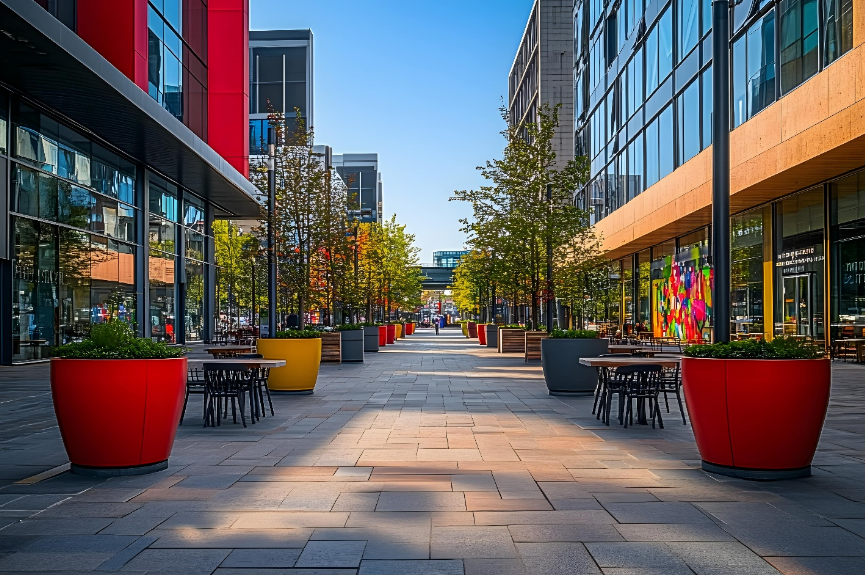As urbanization continues to reshape the world’s cities, the need for inclusive urban spaces has never been more pressing. Urban areas are the melting pots of diverse cultures, socio-economic backgrounds, and abilities. Yet, without intentional design and planning, many cities fail to meet the needs of all their residents. Real estate developers are uniquely positioned to lead the charge in creating equitable, accessible, and inclusive urban environments. David Shulick explores the principles of inclusive design, the benefits of equitable urban spaces, and actionable steps developers can take to foster inclusion.
The Principles of Inclusive Design
Inclusive design is a philosophy that seeks to create environments accessible and usable by as many people as possible, regardless of age, ability, or socio-economic status. It goes beyond compliance with accessibility laws to proactively address the diverse needs of a community. The core principles include:
1. Accessibility
Ensuring physical accessibility for people with disabilities is fundamental. This involves designing spaces that accommodate wheelchairs, walkers, and other mobility aids, as well as incorporating tactile pathways and visual cues for those with sensory impairments.
2. Equity
Inclusive urban spaces provide equal opportunities for everyone to access resources, services, and opportunities. This includes affordable housing, public transportation, and recreational spaces that cater to people from all walks of life.
3. Flexibility
Designs should adapt to the changing needs of individuals and communities. For instance, a multi-functional public square can host farmers’ markets, cultural events, and quiet relaxation areas.
4. Community Engagement
Involving local residents in the planning process ensures that designs reflect the unique needs and aspirations of the community. Participatory planning fosters a sense of ownership and inclusivity.
Why Inclusivity Matters in Urban Development
1. Social Equity
Urban spaces that exclude certain groups perpetuate inequality. By prioritizing inclusivity, developers can contribute to a more equitable society where everyone has the opportunity to thrive.
2. Economic Benefits
Inclusive design attracts a wider demographic, boosting foot traffic and economic activity. For example, accessible retail spaces cater to shoppers with disabilities, families with strollers, and elderly individuals, broadening the customer base.
3. Sustainability
Inclusive urban spaces often incorporate green infrastructure and public transportation, reducing environmental impact. These features make cities more livable and sustainable for future generations.
4. Enhanced Quality of Life
Inclusive spaces improve the well-being of all residents by fostering a sense of belonging, reducing isolation, and encouraging social interaction.
The Role of Real Estate Developers
Real estate developers are key players in shaping the urban landscape. By adopting inclusive practices, they can lead the way in creating spaces that meet the needs of diverse populations. Here are some actionable strategies:
1. Prioritize Universal Design
Universal design goes beyond minimum accessibility standards to create spaces that work for everyone. This might include:
- Installing elevators and ramps alongside stairs.
- Designing wide doorways and hallways.
- Incorporating adjustable-height fixtures in kitchens and bathrooms.
- Using clear, intuitive signage with braille and multiple languages.
2. Integrate Affordable Housing
Inclusive urban development must address the housing needs of low- and middle-income residents. Developers can:
- Dedicate a percentage of units in new developments to affordable housing.
- Partner with local governments to access incentives for building mixed-income communities.
- Design units with flexible layouts to accommodate multigenerational families.
3. Enhance Public Spaces
Public spaces are the heart of inclusive cities. Developers can create welcoming environments by:
- Incorporating seating, shade, and greenery in parks and plazas.
- Designing play areas that are accessible to children of all abilities.
- Ensuring public spaces are safe and well-lit, particularly for women and marginalized groups.
4. Promote Transportation Connectivity
Accessible transportation is a cornerstone of inclusive urban development. Developers can:
- Build near public transit hubs to reduce reliance on cars.
- Provide bicycle racks and pedestrian-friendly pathways.
- Collaborate with municipalities to improve last-mile connectivity for commuters.
5. Engage Communities
Effective urban development requires input from those who will use the space. Developers should:
- Hold public consultations and workshops to gather feedback.
- Partner with local organizations to identify community priorities.
- Incorporate cultural elements that reflect the community’s identity.
Overcoming Challenges
Despite the benefits, creating inclusive urban spaces presents challenges:
1. Financial Constraints
Inclusive designs may involve higher upfront costs. However, developers can offset these costs by leveraging tax incentives, public-private partnerships, and long-term economic gains.
2. Regulatory Hurdles
Navigating zoning laws and building codes can be complex. Developers should advocate for policies that support inclusive practices and work closely with local governments.
3. Resistance to Change
Community members or stakeholders may resist new developments. Transparent communication and evidence of inclusivity’s benefits can help overcome opposition.
Creating inclusive urban spaces is not just a moral imperative but a practical strategy for building resilient, equitable, and thriving communities. Real estate developers have a pivotal role to play in this transformation. By prioritizing accessibility, equity, and community engagement, developers can leave a lasting legacy of urban spaces that meet the needs of all people, regardless of their backgrounds or abilities. In doing so, they not only shape cities but also contribute to a more inclusive and sustainable future.
